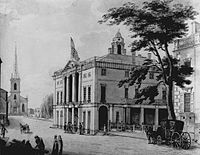|
15th New York State Legislature
The 15th New York State Legislature, consisting of the New York State Senate and the New York State Assembly, met from January 5 to April 12, 1792, during the fifteenth year of George Clinton's governorship, in New York City. BackgroundUnder the provisions of the New York Constitution of 1777, the state senators were elected on general tickets in the senatorial districts, and were then divided into four classes. Six senators each drew lots for a term of 1, 2, 3 or 4 years and, beginning at the election in April 1778, every year six Senate seats came up for election to a four-year term. Assemblymen were elected countywide on general tickets to a one-year term, the whole assembly being renewed annually. In March 1786, the legislature enacted that future legislatures meet on the first Tuesday of January of each year unless called earlier by the governor. No general meeting place was determined, leaving it to each Legislature to name the place where to reconvene, and if no place could be agreed upon, the legislature should meet again where it adjourned. On February 7, 1791, the Legislature re-apportioned the Senate and Assembly districts, according to the figures of the United States Census of 1790. The area of Columbia and Rensselaer counties were transferred from the Western to the Eastern District; and the Southern and the Western districts lost one senator each, which were added to the Eastern District. The total number of assemblymen was again set at 70; but several new counties were established: Herkimer (1 seat), Ontario (1), Otsego (1), Rensselaer (5), Saratoga (4) and Tioga (1); Kings, Orange, Queens, Richmond, Suffolk, Ulster and Westchester lost 1 seat, and Montgomery and New York lost 2; and Columbia won 3 seats. At this time the politicians were divided into two opposing political parties: the Federalists and the Democratic-Republicans.[1] Party lines were not as distinctly drawn then as they became during the 19th century. Some politicians changed sides, for example the Livingston faction of the Federalist Party who felt betrayed after the election of Rufus King over their candidate James Duane in the United States Senate election in New York, 1789 and later voted down Schuyler for re-election in 1791. ElectionsThe State election was held from April 26 to 28, 1791. Senators Samuel Jones (Southern D.), Thomas Tillotson and Jacobus Swartwout (both Middle D.) were re-elected; and Joshua Sands (Southern D.), William Powers (Eastern D.) and Ex-U.S. Senator Philip Schuyler (Western D.) were also elected to the Senate. SessionsThe legislature was to meet for the regular session on January 3, 1792, at Federal Hall in New York City; both Houses assembled a quorum two days later; and adjourned on April 12. On April 12, 1792, they enacted that the legislature should meet on the first Tuesday of November every four years, beginning in 1792, to choose presidential electors. The electors should then meet as electoral college at Poughkeepsie. State SenateDistricts
Note: There are now 62 counties in the State of New York. The counties which are not mentioned in this list had not yet been established, or sufficiently organized, the area being included in one or more of the abovementioned counties. MembersThe asterisk (*) denotes members of the previous Legislature who continued in office as members of this Legislature.
Employees
State AssemblyDistricts
Note: There are now 62 counties in the State of New York. The counties which are not mentioned in this list had not yet been established, or sufficiently organized, the area being included in one or more of the abovementioned counties. AssemblymenThe asterisk (*) denotes members of the previous Legislature who continued as members of this Legislature. Employees
Notes
Sources
|
|||||||||||||||||||||||||||||||||||||||||||||||||||||||||||||||||||||||||||||||||||||||||||||||||||||||||||||||||||||||||||||||||||||||||||||
